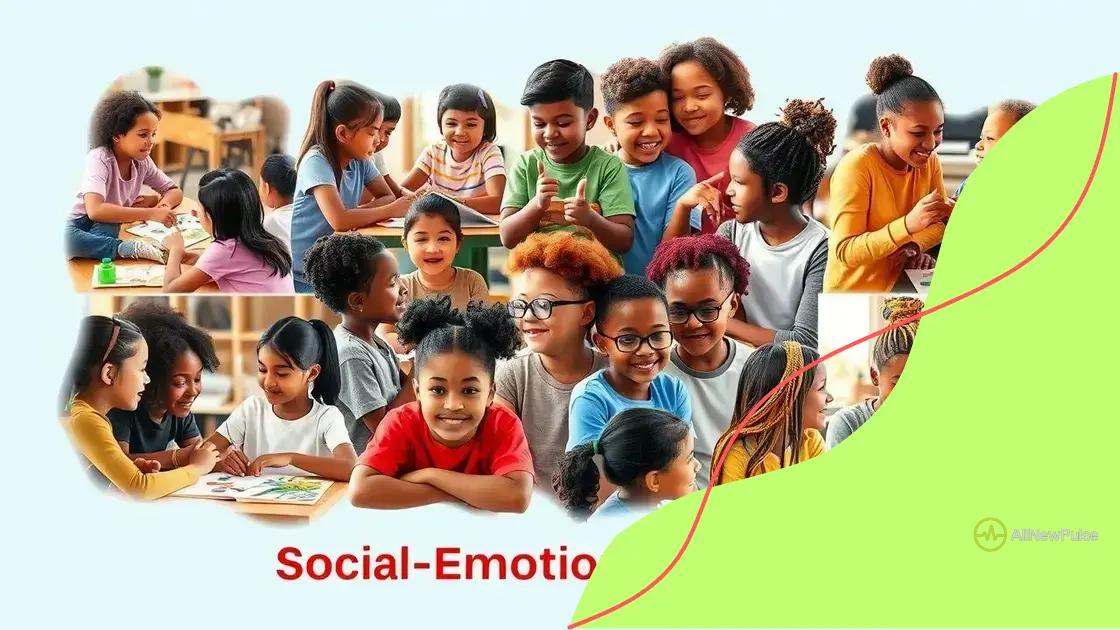The importance of social-emotional learning (SEL) in education

Social-emotional learning (SEL) enhances students’ emotional intelligence, academic performance, and social skills by integrating practices that promote self-awareness, self-management, and relationship building within educational environments.
The importance of social-emotional learning (SEL) cannot be overstated, especially in today’s educational landscape. Have you thought about how it influences our children’s lives, both in and out of school? Let’s explore.
Understanding social-emotional learning (SEL)
Understanding social-emotional learning (SEL) is vital for creating supportive educational environments. SEL focuses on developing skills that help children manage emotions, establish positive relationships, and handle challenges effectively. By integrating SEL into the curriculum, educators foster a holistic approach to student development.
Key Concepts of SEL
At its core, SEL involves several key components that work together to promote emotional and social skills. These include:
- Self-awareness: Recognizing one’s own emotions and values.
- Self-management: Managing emotions and behaviors effectively.
- Social awareness: Understanding the perspectives of others.
- Relationship skills: Building healthy connections and resolving conflicts.
- Responsible decision-making: Making constructive choices regarding personal and social behavior.
By developing these skills, students learn how to interact positively with peers and adults, leading to improved academic performance and emotional well-being. The importance of SEL is seen in the reduction of behavioral issues and increased engagement in the classroom.
Benefits of Understanding SEL
The benefits of understanding social-emotional learning extend beyond the classroom. Students who engage in SEL programs report higher levels of happiness and fulfillment. They also navigate social complexities with greater ease. In essence, SEL helps students become more resilient individuals.
Moreover, as students learn to communicate and collaborate, they build a sense of community. This collaborative spirit fosters a safe learning space where everyone feels valued.
Incorporating social-emotional learning strategies into educational settings equips students not just with academic skills but prepares them for life beyond school. This comprehensive approach nurtures not only intelligent minds but also kind hearts, creating well-rounded individuals ready to succeed in diverse environments.
Key components of SEL
When exploring social-emotional learning (SEL), it’s important to understand its key components. These elements work together to enhance both academic success and personal development.
Core Components of SEL
The foundation of SEL is built on five core components:
- Self-awareness: This involves recognizing emotions and understanding how they influence behavior.
- Self-management: It’s the ability to manage one’s emotions, thoughts, and behaviors effectively.
- Social awareness: Understanding and empathizing with others from diverse backgrounds is crucial in today’s world.
- Relationship skills: Building positive relationships requires effective communication, active listening, and teamwork.
- Responsible decision-making: Students learn to make choices based on ethical standards, safety concerns, and social norms.
Social-emotional learning enhances students’ ability to navigate the social complexities of school and life. By developing these skills early on, students become more resilient and better equipped to handle challenges.
The Interconnectivity of SEL Components
These components are interconnected and continually influence each other. For instance, strong self-awareness can lead to better self-management, which in turn fosters healthier relationships. As students engage with their emotions, they can navigate social interactions more effectively.
Moreover, fostering a positive classroom environment helps enhance these skills. Teachers play a vital role by incorporating activities that encourage emotional expression and reflection. Through open discussions and collaborative projects, students gain practical experience in applying their SEL skills.
By emphasizing the importance of these key components in social-emotional learning, we help cultivate not only academically successful individuals but also empathetic and responsible citizens. This holistic development is essential for thriving in both academic and social settings.
Benefits of SEL for students

The benefits of social-emotional learning (SEL) for students are profound and wide-reaching. By participating in SEL programs, students develop essential life skills that contribute to their overall well-being.
Academic Advantages
Research shows that students equipped with SEL skills perform better academically. This happens because they learn to manage their emotions and focus on their studies. When students understand their feelings, they can combat distractions and engage more effectively in learning activities.
- Improved Grades: SEL fosters better understanding and retention of material.
- Increased Engagement: Students become more interested and involved in class activities.
- Enhanced Collaboration: Students work better together, leading to more effective group projects.
SEL also reduces behavioral issues, allowing for a more focused learning environment. Kids who are emotionally aware are less likely to act out, helping create a positive classroom atmosphere.
Emotional and Social Well-being
Another key advantage of SEL is the enhancement of emotional well-being. Students learn to express their feelings and cope with stress. They also build strong relationships with their peers and teachers, leading to a supportive network that benefits their emotional growth.
These skills not only help students in school but also prepare them for future challenges. For instance, as they enter the workforce, strong relationship skills and emotional intelligence are critical. Kids who practice SEL become aware of their own feelings and those of others, which is key to navigating social interactions smoothly.
Furthermore, SEL promotes resilience. Students learn how to face challenges and setbacks, leading to a positive mindset. This resilience gives them the confidence to tackle hard situations, whether in academics or personal life.
Through these various benefits, it is evident that implementing social-emotional learning in educational settings supports not just academic achievement but a well-rounded and healthy development of students.
Implementing SEL in schools
Implementing social-emotional learning (SEL) in schools is essential for nurturing well-rounded students. Schools can create safe and supportive environments by integrating SEL into the curriculum. This process involves careful planning and a commitment to fostering emotional intelligence alongside academic skills.
Integrating SEL into Curriculum
One effective method to implement SEL is by embedding it into existing subjects. Teachers can create lesson plans that include discussions on emotions, teamwork, and empathy. For example, during group projects, teachers can encourage students to express their feelings and collaborate more effectively.
- Emotional Check-ins: Starting each class with a quick check-in allows students to share how they feel.
- Role-playing: Using scenarios to practice conflict resolution can enhance relationship skills.
- Reflection Activities: Encouraging students to journal about their thoughts and emotions fosters self-awareness.
Integrating these practices helps create a culture that values social-emotional learning. Over time, students become more aware of their emotions and how to handle them.
Training for Educators
Equipping teachers with the right tools is crucial for the success of SEL programs. Professional development workshops can give educators strategies to teach SEL effectively. When teachers understand the importance of SEL, they can model these behaviors for students.
Training can cover various topics, like how to facilitate discussions about emotions and the impact of empathy in classrooms. By giving teachers ongoing support, schools reinforce the importance of SEL in their daily activities.
Moreover, schools should involve families in SEL implementation. Organizing workshops for parents allows them to learn about SEL and support their children at home. This collaborative effort creates a consistent approach to social-emotional learning, enhancing its effectiveness.
Lastly, assessing the impact of SEL programs is vital. Schools can use surveys and feedback from students and teachers to understand what works and where improvements can be made. Regular evaluation helps refine the program and ensures it meets the students’ needs.
Measuring the impact of SEL
Measuring the impact of social-emotional learning (SEL) is essential for understanding its effectiveness in schools. By gathering data, educators can assess how well SEL programs are improving students’ emotional and social skills.
Importance of Assessment
To effectively evaluate SEL, schools should use a variety of assessment tools to capture a comprehensive view of student growth. These assessments can provide information on how students are developing key skills like self-awareness, relationship management, and responsible decision-making. Tracking these changes helps schools refine their programs to better meet student needs.
- Surveys: Student and teacher surveys can gauge perceptions of SEL effectiveness and emotional climate in the classroom.
- Behavioral Observations: Direct observation of student interactions can reveal changes in behavior and emotional expression.
- Academic Performance: Analyzing student grades and test scores can show correlations between SEL participation and academic success.
When schools collect this data, they can identify trends and measure success rates effectively. For instance, if surveys show that students feel more connected to their peers, it indicates positive growth in SEL skills.
Longitudinal Studies
Longitudinal studies are another powerful way to measure SEL impact over time. By tracking students’ progress as they move through grades, schools can see how early SEL exposure influences behavior and academic performance later on. This type of research provides valuable insights into the long-term benefits of SEL.
Schools can also consider tracking students’ mental health and emotional well-being through assessments and interviews. Understanding the broader impact of SEL on life skills and emotional resilience is critical for justifying its place in the educational system.
Moreover, engaging parents and communities in the assessment process can enhance the impact of SEL. Gathering feedback from families allows for adjustments that reflect students’ home environments. By fostering a community-centered approach, schools can amplify the positive effects of SEL.
Ultimately, measuring the impact of social-emotional learning not only helps schools improve their programs but also supports students’ overall development in a meaningful way.
FAQ – Frequently Asked Questions about Social-Emotional Learning (SEL)
What is social-emotional learning (SEL)?
SEL is a process that helps students learn to manage their emotions, set goals, show empathy, and establish positive relationships.
How does SEL benefit students academically?
Students with strong SEL skills tend to perform better academically as they engage more with their learning and manage stress effectively.
What methods can schools use to measure the impact of SEL?
Schools can use surveys, behavioral observations, and academic performance to evaluate the effectiveness of their SEL programs.
Why is teacher training important for implementing SEL?
Equipping teachers with SEL strategies is crucial for effectively teaching students emotional and social skills, creating a supportive learning environment.





